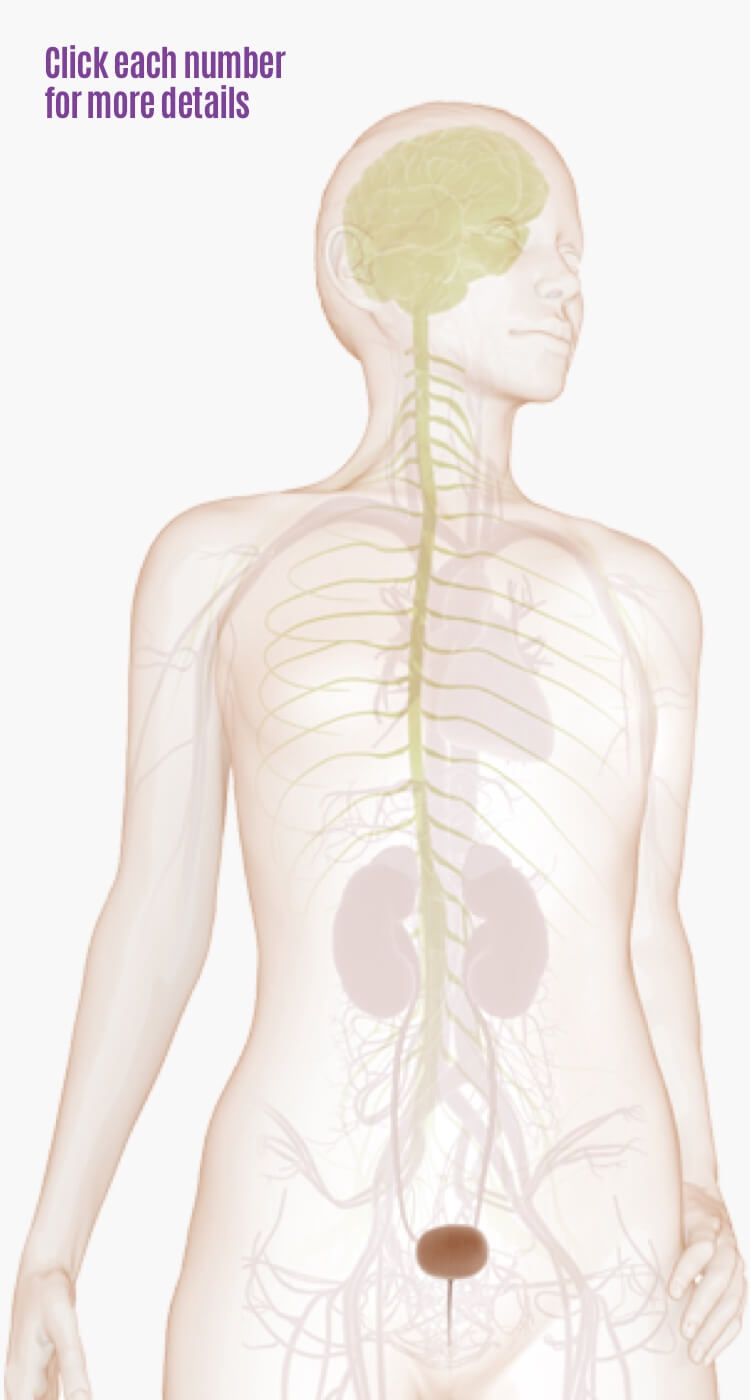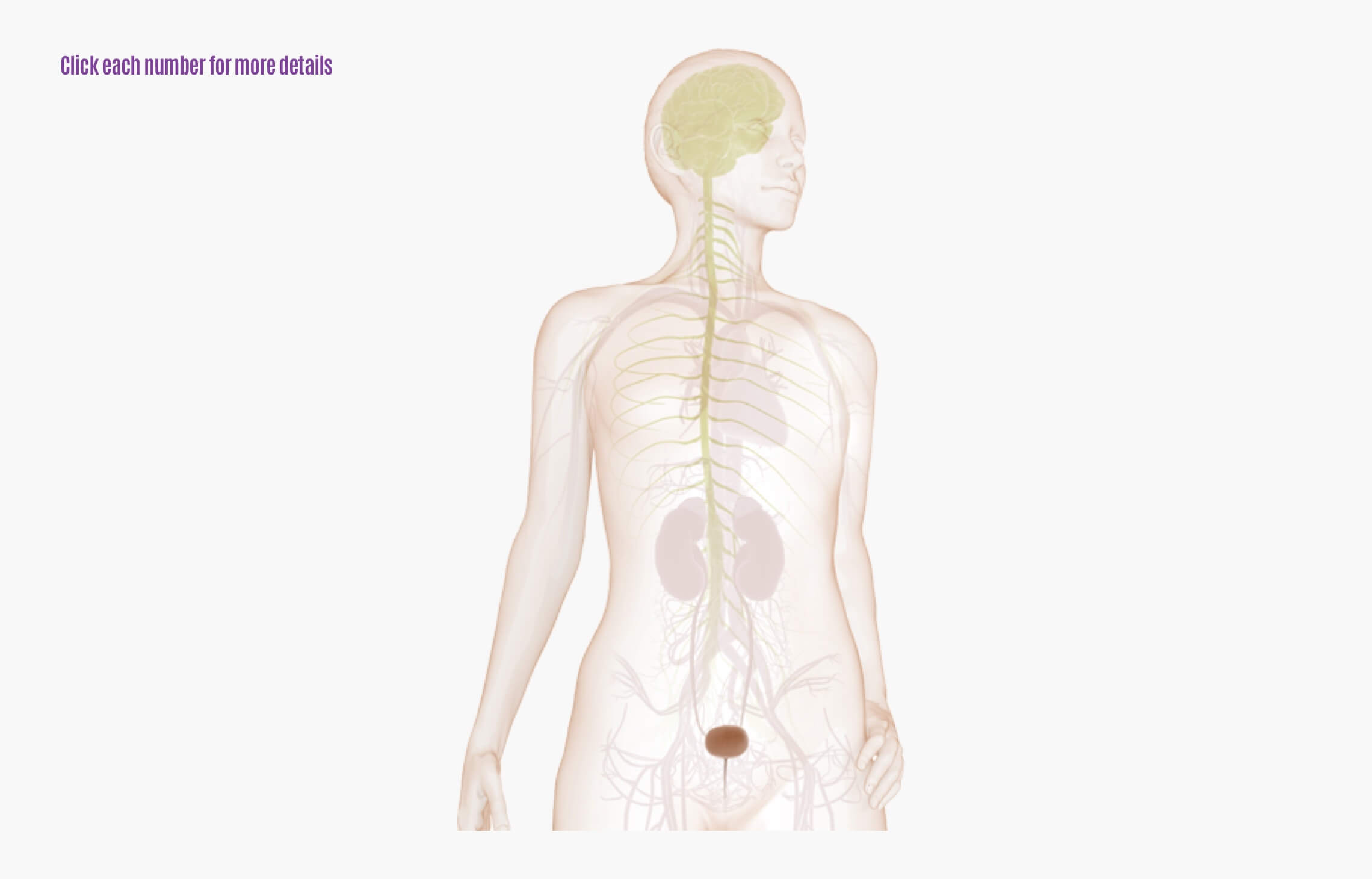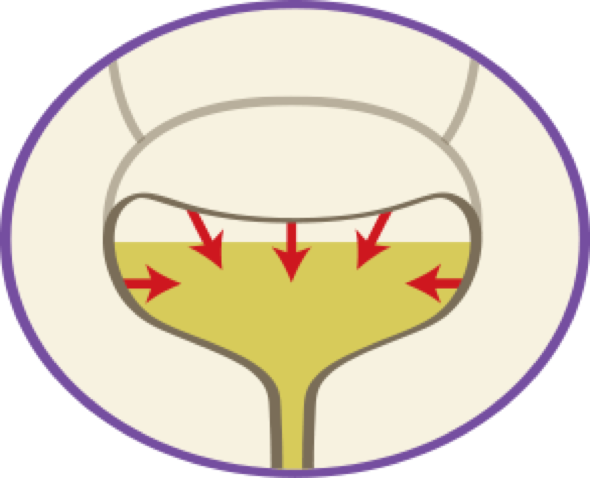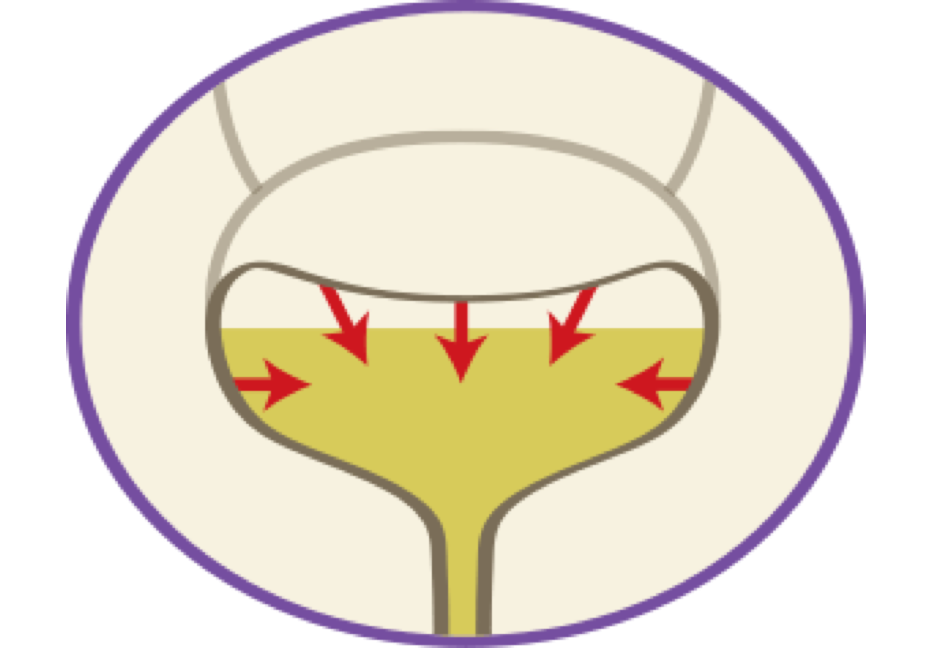INDICATIONS
BOTOX® (onabotulinumtoxinA) is a prescription medicine that is injected into the bladder muscle and used:
- To treat overactive bladder symptoms such as a strong need to urinate with leaking or wetting accidents (urge urinary incontinence), a strong need to urinate right away (urgency), and urinating often (frequency) in adults 18 years and older when another type of medicine (anticholinergic) does not work well enough or cannot be taken
- To treat leakage of urine (incontinence) in adults 18 years and older with overactive bladder due to a neurologic disease when another type of medicine (anticholinergic) does not work well enough or cannot be taken
- To treat overactive bladder due to a neurologic disease in children 5 years of age and older when another type of medicine (anticholinergic) does not work well enough or cannot be taken
IMPORTANT SAFETY INFORMATION
BOTOX may cause serious side effects that can be life threatening. Get medical help right away if you have any of these problems any time (hours to weeks) after injection of BOTOX:
- Problems swallowing, speaking, or breathing, due to weakening of associated muscles, can be severe and result in loss of life. You are at the highest risk if these problems are preexisting before injection. Swallowing problems may last for several months.
- Spread of toxin effects. The effect of botulinum toxin may affect areas away from the injection site and cause serious symptoms, including loss of strength and all-over muscle weakness; double vision; blurred vision; drooping eyelids; hoarseness or change or loss of voice; trouble saying words clearly; loss of bladder control; trouble breathing; and trouble swallowing.
BOTOX may cause loss of strength or general muscle weakness, vision problems, or dizziness within hours to weeks of receiving BOTOX. If this happens, do not drive a car, operate machinery, or do other dangerous activities.
Do not receive BOTOX if you are allergic to any of the ingredients in BOTOX (see Medication Guide for ingredients); had an allergic reaction to any other botulinum toxin product such as Myobloc® (rimabotulinumtoxinB), Dysport® (abobotulinumtoxinA), Xeomin® (incobotulinumtoxinA), Jeuveau® (prabotulinumtoxinA-xvfs), Daxxify® (daxibotulinumtoxinA-lanm), or Letybo® (letibotulinumtoxinA-wlbg) (this may not be a complete list of all botulinum toxin products); have a skin infection at the planned injection site.
Do not receive BOTOX for the treatment of urinary incontinence if you have a urinary tract infection (UTI) or cannot empty your bladder on your own and are not routinely catheterizing. Due to the risk of urinary retention (difficulty fully emptying the bladder), only patients who are willing and able to initiate catheterization posttreatment, if required, should be considered for treatment.
Patients treated for overactive bladder: In clinical trials, 36 of the 552 patients had to self-catheterize for urinary retention following treatment with BOTOX compared to 2 of the 542 treated with placebo. The median duration of postinjection catheterization for these patients treated with BOTOX 100 Units (n = 36) was 63 days (minimum 1 day to maximum 214 days), as compared to a median duration of 11 days (minimum 3 days to maximum 18 days) for patients receiving placebo (n = 2). Patients with diabetes mellitus treated with BOTOX were more likely to develop urinary retention than nondiabetics.
Adult patients treated for overactive bladder due to a neurologic disease: In clinical trials, 30.6% of adult patients (33/108) who were not using clean intermittent catheterization (CIC) prior to injection required catheterization for urinary retention following treatment with BOTOX 200 Units, as compared to 6.7% of patients (7/104) treated with placebo. The median duration of postinjection catheterization for these patients treated with BOTOX 200 Units (n = 33) was 289 days (minimum 1 day to maximum 530 days), as compared to a median duration of 358 days (minimum 2 days to maximum 379 days) for patients receiving placebo (n = 7).
Among adult patients not using CIC at baseline, those with multiple sclerosis were more likely to require CIC postinjection than those with spinal cord injury.
The dose of BOTOX is not the same as, or comparable to, another botulinum toxin product.
Serious and/or immediate allergic reactions have been reported, including itching; rash; red, itchy welts; wheezing; asthma symptoms; dizziness; or feeling faint. Get medical help right away if you experience symptoms; further injection of BOTOX should be discontinued.
Tell your doctor about all your muscle or nerve conditions, such as ALS or Lou Gehrig’s disease, myasthenia gravis, or Lambert-Eaton syndrome, as you may be at increased risk of serious side effects, including difficulty swallowing and difficulty breathing from typical doses of BOTOX.
Tell your doctor if you have any breathing-related problems. Your doctor may monitor you for breathing problems during treatment with BOTOX for detrusor overactivity associated with a neurologic condition. The risk of developing lung disease in patients with reduced lung function is increased in patients receiving BOTOX.
Autonomic dysreflexia in patients treated for overactive bladder due to a neurologic disease. Autonomic dysreflexia associated with intradetrusor injections of BOTOX could occur in patients treated for detrusor overactivity associated with a neurologic condition and may require prompt medical therapy. In clinical trials, the incidence of autonomic dysreflexia was greater in adult patients treated with BOTOX 200 Units compared with placebo (1.5% versus 0.4%, respectively).
Tell your doctor about all your medical conditions, including if you have or have had bleeding problems; have plans to have surgery; had surgery on your face; have weakness of forehead muscles, trouble raising your eyebrows, drooping eyelids, and any other abnormal facial change; have symptoms of a UTI and are being treated for urinary incontinence (symptoms of a UTI may include pain or burning with urination, frequent urination, or fever); have problems emptying your bladder on your own and are being treated for urinary incontinence; are pregnant or plan to become pregnant (it is not known if BOTOX can harm your unborn baby); are breastfeeding or plan to (it is not known if BOTOX passes into breast milk).
Tell your doctor about all the medicines you take, including prescription and over-the-counter medicines, vitamins, and herbal supplements. Using BOTOX with certain other medicines may cause serious side effects. Do not start any new medicines until you have told your doctor that you have received BOTOX in the past.
Tell your doctor if you received any other botulinum toxin product in the last 4 months; have received injections of botulinum toxin such as Myobloc®, Dysport®, Xeomin®, Jeuveau®, Daxxify®, or Letybo® in the past (this may not be a complete list of all botulinum toxin products; tell your doctor exactly which product you received); have recently received an antibiotic by injection; take muscle relaxants; take an allergy or cold medicine; take a sleep medicine; take aspirin-like products or blood thinners.
Other side effects of BOTOX include dry mouth; discomfort or pain at the injection site; tiredness; headache; neck pain; eye problems such as double vision, blurred vision, decreased eyesight, drooping eyelids, swelling of your eyelids, and dry eyes; drooping eyebrows; and upper respiratory tract infection. In adults being treated for urinary incontinence, other side effects include UTI and painful urination. In children being treated for urinary incontinence, other side effects include UTI; bacteria, white blood cells, and blood in the urine. In patients being treated for urinary incontinence, another side effect includes the inability to empty your bladder on your own. If you have difficulty fully emptying your bladder on your own after receiving BOTOX, you may need to use disposable self-catheters to empty your bladder up to a few times each day until your bladder is able to start emptying again.
For more information, refer to the Medication Guide or talk with your doctor.
You are encouraged to report negative side effects of prescription drugs to the FDA. Visit www.fda.gov/medwatch or call 1-800-FDA-1088.
Please see full Product Information, including Boxed Warning and Medication Guide, or visit https://www.rxabbvie.com/pdf/botox_pi.pdf
If you are having difficulty paying for your medicine, AbbVie may be able to help. Visit AbbVie.com/PatientAccessSupport to learn more.
US-BTX-240443







